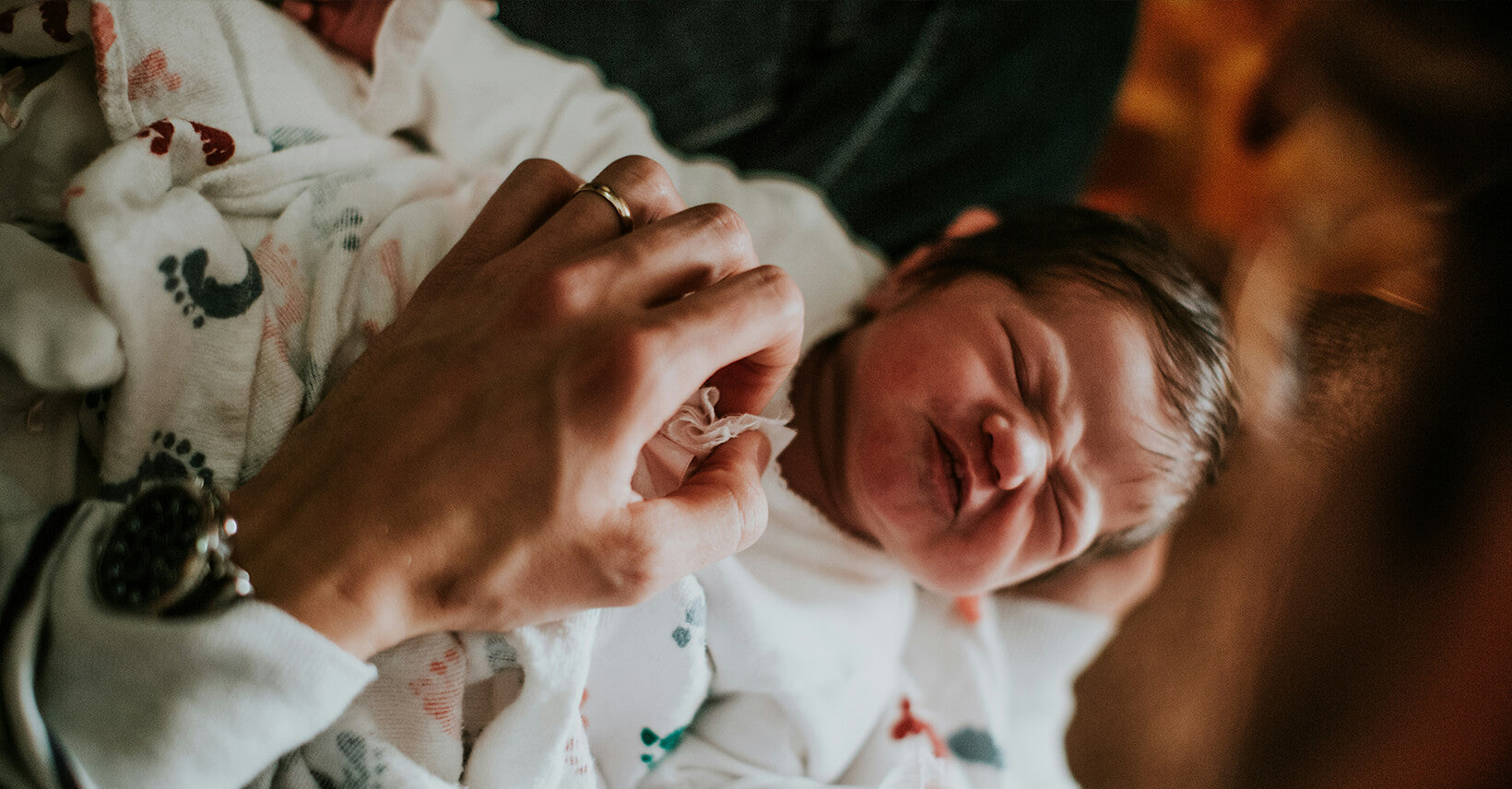
What to Do If the Baby Rolls Onto Stomach While Sleeping?
If your baby rolls onto his or her stomach while sleeping, but can't roll back, this can be worrying for parents. It's normal to worry about your baby's safety while sleeping. Many pediatricians recommend putting babies to sleep on their backs to reduce the risk of sudden infant death syndrome (SIDS).
However, once babies learn to roll over, they usually do so independently. If your baby finds themselves sleeping on their stomach and unable to roll over at bedtime, there are some tips that you can take to ensure their safety without causing too much disruption to their sleep habits in today’s share.
- When do babies roll over?
- Why the baby can not roll back?
- Why do babies roll over while asleep?
- Baby Won't Sleep Without Swaddle But Rolls Over
- What to do if the baby rolls over while sleeping but can’t roll back?
- Conclusion
- FAQ
When do babies roll over?
So when do babies start rolling over? Many new parents have this question. Rolling over is a very special milestone in your little one's early development. So, let's find out more about it.
Babies usually start rolling over when they are three to six months old. Yes, this is the window in which they begin to master rolling over.
Why the baby can not roll back?
There are two directions when babies are rolling: stomach to back and back to stomach.
Initially, babies often roll from their stomachs to their backs because the muscles in their neck and upper body are stronger than those in their abdomen. Additionally, the reflexes that help babies lift their heads while lying on their stomachs also help babies to roll.
As babies continue to develop and strengthen their muscles, they eventually learn to roll in both directions, from their back to their stomach and from their stomach to their back. So, when you see your little one rolling back, it's a sign of their growing strength and coordination! Let’s give them the applause!
Why do babies roll over while asleep?
If your baby rolls over in their sleep, it is another aspect of their growing independence and motor skills.
Babies rolling over in their sleep is usually a natural part of their sleep behavior. As babies grow and develop, they become more mobile, even during sleep. Below are some reasons why babies roll over while asleep:
try to find a comfortable sleeping position
Studies have shown that babies roll over in their sleep because they are naturally trying to find a comfortable position. Just as adults may toss and turn to get comfortable, infants may roll over to relieve pressure points or adjust their position to get a better night's sleep.
the transition between sleep stages
In addition, some infants may roll over when transitioning between sleep stages, such as from deep to light sleep cycles.
some babies may prefer to sleep on their stomach
Some babies may prefer to sleep on their stomachs. Because sleeping on their stomachs can make them feel more comfortable. Sleeping on stomachs also helps some babies relieve other conditions such as acid reflux or gas.
It is important to note that while rolling over in sleep is generally considered normal, parents must follow safe sleep practices, such as putting their baby to sleep on his or her back to reduce the risk of Sudden Infant Death Syndrome (SIDS).

Baby Won't Sleep Without Swaddle But Rolls Over
If an infant can't fall asleep without swaddling, but then begins to roll over, this can be a tricky issue for parents.
A swaddle is a common item used to help newborns feel secure and mimic the comfort of the womb. Many babies feel comfortable in swaddling, which can help them settle down and sleep better.

Front Opening Zip Up Swaddle 0.5 TOG - $33
However, once babies begin to roll over, it is recommended that swaddling be discontinued to prevent the risk of suffocation or injury. This transition can be challenging for both the baby and the parents, as it may be difficult for the baby to settle without the familiar swaddle.
Parents must gradually wean their baby off the swaddle using another sleep environment, such as a baby sleep sack or a cozy sleep environment, to ensure babies’ safety while promoting healthy sleep habits. While it may take some time for your baby to adjust to sleeping without a swaddle, with patience and persistence, they will eventually learn to sleep safely and comfortably in their new sleeping position.

Kaiya Baby Sleep Sack - Shop Now
What to do if the baby rolls over while sleeping but can’t roll back?
If a baby rolls over while sleeping but can't roll back, there are some steps parents can take to ensure their safety.
Ensure a safe sleep environment:
Make sure your baby's sleeping surface is firm and free of any soft bedding or items that could pose a choking hazard. This includes removing pillows, blankets, and stuffed animals from the crib.
Monitor closely:
Keep a close eye on your baby during their sleep to make sure they are safe. If they roll onto their tummy but can't roll back, gently put them back on their back to reduce the risk of Sudden Infant Death Syndrome (SIDS).
Consider sleep sacks:
Some parents find that using a baby sleep sack or wearable blanket instead of a traditional blanket keeps their baby safe when they roll over in their sleep.
Practice supine time:
Encourage your baby to do regular sit-ups when they are awake to help strengthen their neck and upper body muscles, making it easier for them to roll over independently.
Avoid baby sleep positioners:
Experts debate the safety of infant sleep positioners. While some manufacturers claim that sleep positioners can help infants stay in specific positions during sleep and reduce the risk of sudden infant death syndrome (SIDS), there is limited evidence to support these claims.
In fact, the American Academy of Pediatrics (AAP) recommends against the use of sleep positioners because of the risk of suffocation if an infant rolls over onto his or her stomach or becomes trapped in the positioner. In addition, the U.S. Consumer Product Safety Commission (CPSC) has warned of the dangers of sleep positioners and recommends against their use.
Resources:
https://publications.aap.org/aapnews/news/1444/Health-Alerts-Infant-sleep-positioners-bouncer
https://www.cpsc.gov/Newsroom/Video/Sleep-Positioners-A-Suffocation-Risk
Therefore, it is important for parents to prioritize safe sleep practices recommended by trusted healthcare providers as we listed above.
Consult your pediatrician:
If parents have concerns about their baby's ability to roll over, or if your baby consistently struggles to roll over in their sleep, it's important to seek guidance from your pediatrician. They can provide personalized advice and support based on your baby's individual needs.
Conclusion
In conclusion, if a baby rolls onto their stomach while sleeping but can't roll back, there are steps parents can take to ensure their safety without causing too much disruption to their sleep routine in the above content.
By following these guidelines and consulting with a pediatrician if needed, parents can help ensure their baby sleeps safely and soundly.
FAQ
What age do babies roll over in their sleep?
As mentioned earlier, the exact age at which babies can roll on their stomachs varies from person to person. Some little ones can safely roll over and sleep on their stomachs at around 3-6 months of age. Others may not reach this age until 6 months or later. Just keep an eye on your baby’s ability.
How long does the rolling phase last?
Some babies will wake up crying after they roll into an uncomfortable position during sleep. This phase will last about a few weeks till your little one develops their strength and mobility to help them roll back into a more comfortable position.
Does rolling cause sleep regression?
Rolling over is not really a sleep regression and will not permanently alter your baby's sleep schedule. Rolling will only temporarily disrupt your baby's sleep. However, your baby will need your help to help him or her get through this period.
What are the first signs of rolling?
The first sign that your baby is ready to roll over is usually increased strength and mobility in the upper body. These signs may include
- Increased force when lying on the stomach.
- Rocking back and forth
- Head turning to one side.
- Kicking the legs.
These signs usually indicate that your baby is building the strength and coordination necessary to eventually be able to roll over independently. It is important that parents continue to provide their babies with plenty of tummy time to help them develop these skills further.

Yujia Shi
An expert in sleep sack design, is a valued contributor to Kaiya Baby's blog. With a strong background in baby sleep bags and maternal care, she is highly regarded for her professionalism. Yujia Shi prioritizes baby comfort and safety in her designs, using high-quality materials. Her insightful articles on sleep bags have been featured in reputable publications and have gained a significant readership. Trust Yujia Shi to help you create a comfortable and safe sleep environment for your baby, backed by her proven track record in the industry.



Leave a comment
This site is protected by reCAPTCHA and the Google Privacy Policy and Terms of Service apply.